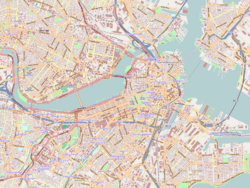Bulfinch Triangle Historic District facts for kids
Quick facts for kids |
|
|
Bulfinch Triangle Historic District
|
|

1887 Lockhart Building
|
|
| Location | West End, Boston, Massachusetts |
|---|---|
| Area | 7 acres (2.8 ha) |
| Architect | Bulfinch, Charles |
| Architectural style | Beaux Arts, Second Empire, Romanesque |
| NRHP reference No. | 86000274 |
| Added to NRHP | February 27, 1986 |
The Bulfinch Triangle Historic District is a special area in Boston, Massachusetts. It's called a historic district because it has many old buildings that are important to history. This district is found in the West End part of Boston. It's roughly bordered by Canal, Market, Merrimac, and Causeway Streets.
The famous architect Charles Bulfinch designed this whole area. He created it on land that was once underwater! This land was "reclaimed" from an old pond called Mill Pond. Today, the Bulfinch Triangle is full of old commercial buildings. Most of these buildings were built between the 1870s and early 1900s. This historic district was added to the National Register of Historic Places in 1986. This means it's officially recognized as a place worth protecting.
Contents
What is the Bulfinch Triangle?
The Bulfinch Triangle is located north of Boston's Government Center. The TD Garden is to its north, and the North End is to its east. The West End is to its west. The historic district's edges are Causeway Street to the north, Canal Street to the east, and Merrimac Street to the southwest.
How the Land Was Made
A long time ago, this area was under water. It was a part of the Charles River called North Cove. This was a muddy area that was filled in with land starting in 1807. The northern edge of this new land became Causeway Street.
Charles Bulfinch, the architect, planned the streets for the people who owned the land. The area was filled using dirt and rocks from Beacon Hill and Copp's Hill. These hills were made lower to get the material needed.
A Hub for Business
After the land was created, the Bulfinch Triangle became a busy spot for early railroads. These trains connected Boston to places north and west of the city. This helped the area grow into a place for manufacturing. Over time, the train stations all moved into one big station called North Station.
By the late 1800s, the Bulfinch Triangle was a major center for Boston's furniture trade. Buildings here had both factories and showrooms where furniture was made and sold.
Buildings and Their Styles
There are 59 buildings in the Bulfinch Triangle historic district. Most of them are five or six stories tall. They are built from brick and stone. Many buildings show styles from the late 1800s, like the Renaissance Revival. This style was very popular back then.
One special building is at 48–72 Canal Street. It was designed by Gridley J. F. Bryant and finished in 1871. This building is a great example of the Second Empire style. You can also find good examples of the Beaux Arts style here. Two buildings on Portland Street, designed by Stephen Codman, show this style. Some older buildings from the mid-1800s are on Causeway Street. However, parts of them have been changed over the years.




